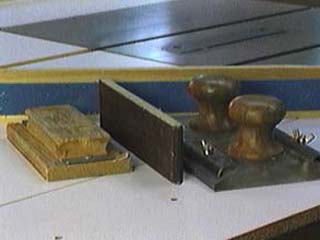

Hardblock to Happiness The one thing I've seen in almost every professional woodshop aside from tablesaws and compressors is what is commonly known as a "hardblock".
Invariably this is a small sanding belt tightly wrapped around an oblong block made of wood, plywood, MDF, particleboard, MCP, acrylic, etc. One guy even has his hardblocks made of walnut in a variety of grits.
The first thing you notice when you pick one of these things up is, "How did they get these belts so tight?" After some inspection it becomes clear the belts were wrapped loose, and then shims were forced in the ends between the belt and the block. Personally, I like to use common nails. They are inserted slowly between the belt and block-end with a hammer. Since the belt is used until it's exhausted, removal of the shims is easy by just tearing off the belt or slipping the nails out by their heads
For a 3X24 belt, you'll need a 1/2" block 11 3/8" long. Width can vary depending on what you want your block for. 4" or larger is good for flattening large surfaces while a 2" wide belt stays on a narrow edge. But you'll get the idea after you make your first hardblock and put it to use.
From left to right in foreground:
1) Half-sheet block for normal sandpaper.
2) Block with 80 grit 3x24 belt.
3) Full-sheet acrylic block for wet sanding and large surfaces.Background:
2" 40 grit belt opened and stapled to poplar board.
